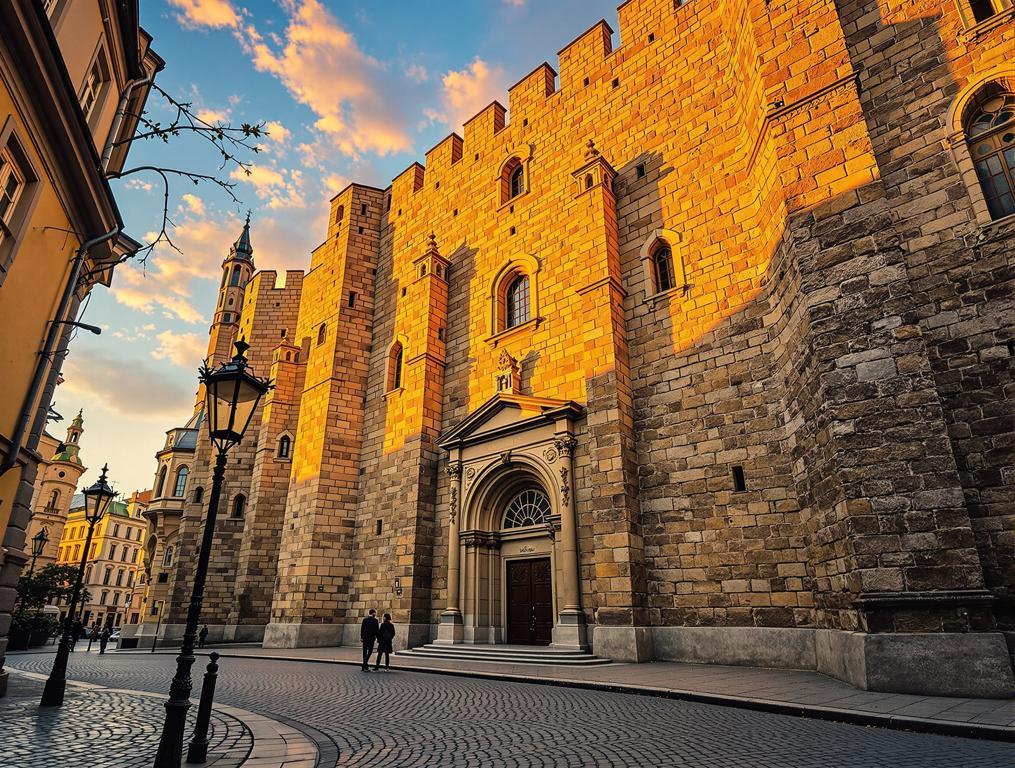I’m standing before a massive synagogue with walls so thick they could withstand a medieval siege. The two-meter thick walls rise from the cobblestone street of Zhovkva, a small Ukrainian town just 30 kilometers north of Lviv. What makes this 17th-century stone structure extraordinary isn’t just its imposing presence in a town of 13,852 residents – it’s that I’m looking at Europe’s only surviving fortress-synagogue, a mysterious architectural anomaly that combines Jewish religious architecture with military defensive features.
Europe’s Only Fortress Synagogue Hides Renaissance Secrets Behind 2-Meter Walls
The Zhovkva synagogue stands as a powerful contradiction. While most European synagogues were built as purely religious structures, this one was designed for prayer and protection. Dating from 1692, it features attic loopholes cleverly disguised behind decorative visors – perfect for defenders to fire through while remaining hidden.
Walking around the structure, I notice the massive buttresses that reinforce the walls. My local guide explains that the synagogue’s defensive design wasn’t just architectural flourish – it was survival strategy. In an era of frequent attacks, the Jewish community created this innovation to protect themselves and their sacred texts.
“The walls weren’t just symbolic protection,” my guide explains. “They were practical. During sieges, the entire Jewish community could shelter inside these walls while defenders used the attic positions.”
The synagogue’s interior reveals another layer of uniqueness. The nine-bay vault system created remarkable acoustics for prayer, while the elaborate Baroque Torah niche contrasts dramatically with the fortress-like Renaissance exterior. This rare architectural fusion tells a story of cultural resilience in a region marked by centuries of conflict.
How This Ukrainian Architectural Marvel Combines Prayer and Protection
While Lviv attracts most tourists to the region with its UNESCO-listed old town, Zhovkva offers something entirely different. Unlike the cosmopolitan European capitals that showcase their historical preservation, Zhovkva preserves a complete Renaissance town plan with the synagogue as its crowning architectural achievement.
The town was designed as an “ideal city” following Renaissance principles, with orthogonal streets and a central square. What makes Zhovkva special is how completely this plan survives, rivaling similar undiscovered European villages in Italy but with a distinctly Eastern European character.
“I’ve visited synagogues across Europe, but nothing compares to this. The combination of religious architecture with military engineering feels like discovering a secret chapter of Jewish history that nobody told us about.”
What makes the synagogue’s survival even more remarkable is that it nearly didn’t make it. During WWII, Nazis attempted to destroy it, severely damaging the interior and women’s galleries. Unlike many Jewish heritage sites across Europe, however, the fortress-like construction prevented complete destruction.
King Jan III Sobieski, who became famous for saving Vienna from Ottoman forces, personally contributed 6,000 zlotys to build this stone synagogue after a fire destroyed its wooden predecessor. His involvement explains why such a small town boasts such an extraordinary structure.
What The Guidebooks Won’t Tell You About Visiting
The best way to experience Zhovkva is to arrive before the day-trippers from Lviv. I recommend visiting at 8:00 AM when morning light illuminates the synagogue’s eastern facade. Park at the free municipal lot near Vicheva Square and explore the compact historical center on foot.
Unlike other historic fortifications that charge premium entrance fees, the synagogue’s exterior can be appreciated without cost. The interior is undergoing restoration to become a Jewish heritage center, so check local schedules for access.
Don’t miss the hidden mikvah (ritual bath) foundations nearby or the remnants of the Jewish Gate that once connected to the city walls. These elements tell a complete story of Jewish life beyond just religious worship.
For context, visit Zhovkva Castle just 250 meters away, which shares the same Renaissance-meets-military architectural philosophy. The preservation challenges facing both structures are similar, though the synagogue’s restoration has gained more international support.
As I depart Zhovkva, the image of that fortress synagogue stays with me – a powerful reminder that sometimes history’s most profound stories aren’t found in famous capitals but in quiet corners where communities built ingenious solutions to survive. The walls that once protected a community now protect their memory, standing as testament to human resilience in the face of repeated threats. If you’re looking for Europe’s untold stories, they’re hiding in plain sight behind those two-meter walls.
